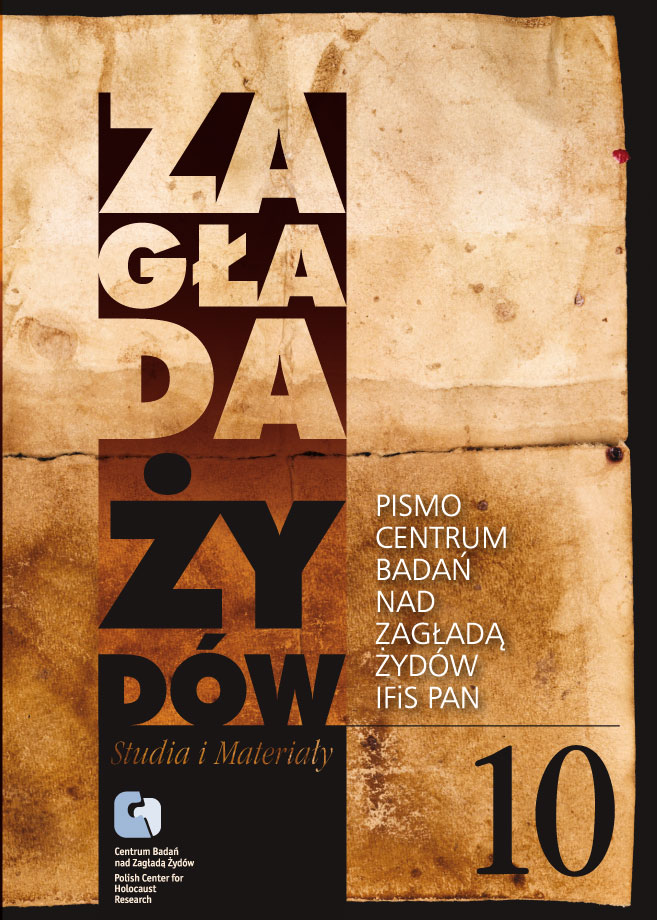Józef Kermisz (1907–2005) – twórca badań nad Szoa
Zagłada Żydów. Studia i Materiały, Nr 10 (2014), Strony: 304-316
Data zgłoszenia: 2020-10-22Data publikacji: 2014-12-01
 https://doi.org/10.32927/ZZSiM.526
https://doi.org/10.32927/ZZSiM.526
Abstrakt
Józef Kermisz (1907–2005) was a historian and an archivist who helped lay the foundations for Shoah research in Poland and Israel. In 1944 joined the Central Jewish Historical Commission where became the chief archivist. Since then his life has been devoted to retrieving wartime archival material. As archive director (in the Jewish Historical Institute in Poland and at Yad Vashem in Israel) he sought to develop an archive both for future historical research and for trials of suspected war criminal. He played a major role in discovering and preserving important documentation on the Shoah in Poland. Among his major professional achievements were preparing documentation for the prosecution in the Eichmann trial, and publishing Czerniakow’s diary and the full edition of the underground press of the Warsaw ghetto. He was one of the world’s leading experts on the Ringelblum Archive and other hidden Jewish documentation from the Holocaust. Kermisz left behind a legacy of a vast research infrastructure that he created and that will occupy scholars for generations.
Licencja
Prawa autorskie (c) 2014 Autor&"Zagłada Żydów. Studia i Materiały"

Utwór dostępny jest na licencji Creative Commons Uznanie autorstwa 4.0 Międzynarodowe.
https://creativecommons.org/licenses/by/4.0
Czasopismo publikowane jest w standardzie Diamond Open Access na licencji CC-BY-4.0 Deed - Uznanie autorstwa 4.0 Międzynarodowa - Creative Commons
Inne teksty tego samego autora
- Avner Shalev, Dan Michman, David Silberklang, Ścisła pamięć o Zagładzie w Muzeum Historii Holokaustu w Yad Vashem. Odpowiedź na artykuł Amosa Goldberga , Zagłada Żydów. Studia i Materiały: Nr 7 (2011)
Podobne artykuły
- Adriana Bryk, „Najlepsze dziecko Prezesa” – poczta w getcie łódzkim (1939–1944) , Zagłada Żydów. Studia i Materiały: Nr 16 (2020)
- Omer Bartov, Wołanie krwi brata twego. Rekonstrukcja ludobójstwa w lokalnej skali , Zagłada Żydów. Studia i Materiały: Nr 10 (2014)
- Janusz Salamon, SJ, Dialog chrześcijańsko-żydowski w krainie schorowanej wyobraźni. Na marginesie książki Waldemara Chrostowskiego Kościół, Żydzi, Polska , Zagłada Żydów. Studia i Materiały: Nr 5 (2009)
- Tomasz Frydel, Zwykła organizacja, nadzwyczajna przemoc państwowa. Polska policja granatowa a Zagłada we wschodniej części dystryktu krakowskiego , Zagłada Żydów. Studia i Materiały: Nr 17 (2021)
- Jan Tomasz Gross, O kolaboracji , Zagłada Żydów. Studia i Materiały: Nr 2 (2006)
- Michał Trębacz, Karski–Zygielbojm. Historia pewnej rozmowy , Zagłada Żydów. Studia i Materiały: Nr 18 (2022)
- Paweł Dobrosielski, Opowiadanie Marka Hłaski „Szukając gwiazd” jako parabola Holokaustu i mityczne „wydarzenie początkowe” w twórczości pisarza , Zagłada Żydów. Studia i Materiały: Nr 4 (2008)
- Mordechay Giloh, Odmienne sylwetki przybyłych do Szwecji więźniów pochodzenia żydowskiego i nieżydowskiego, ocalałych z obozów koncentracyjnych na ziemiach polskich , Zagłada Żydów. Studia i Materiały: Nr 8 (2012)
- Adam Sitarek, W obliczu „trudnej konieczności”. Administracja żydowska getta łódzkiego wobec wsiedleń Żydów z Rzeszy i Protektoratu (październik–listopad 1941 r.) , Zagłada Żydów. Studia i Materiały: Nr 8 (2012)
- Justyna Kowalska-Leder, The Omnipresence of the Righteous , Zagłada Żydów. Studia i Materiały: Nr Holocaust Studies and Materials (2017)
<< < 23 24 25 26 27 28 29 30 31 32 33 34 35 36 37 38 39 40 41 42 43 44 45 46 47 48 49 50 51 52 53 54 55 56 57 58 59 60 61 62 63 64 65 66 67 68 69 70 71 > >>
Możesz również Rozpocznij zaawansowane wyszukiwanie podobieństw dla tego artykułu.
 English
English
 Język Polski
Język Polski




